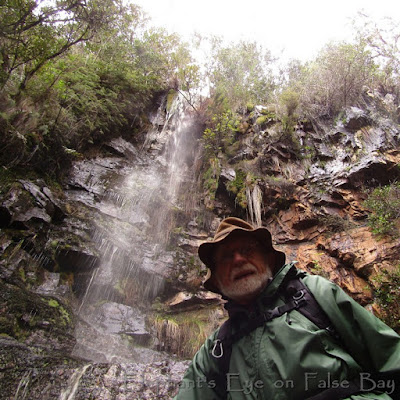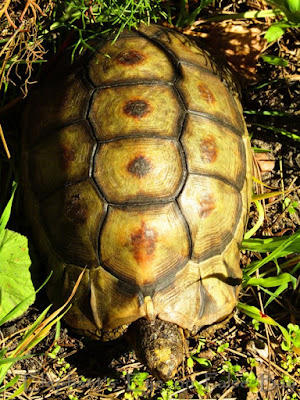Spring flowers from Rondebosch Common and Smitswinkel Bay
by Diana
Studer
- gardening for biodiversity
in Cape Town, South Africa
Hiking among
wildflowers
and in the mountains
around Cape Town
A drizzly day as we walked on Rondebosch Common. Delighted
to see the reintroduced Moraea aristata
blooming. The last surviving population is at the Observatory among some unmown
grass. Seeds were harvested and a suitable new home ... Rondebosch Common ...
was found. In 2017 corms from the Observatory seeds were planted. In 2018 more
from Kew's Millennium Seed Project. The flowers are being pollinated by monkey
beetles, and setting seed. After 3 years of seed setting we can count the new
population as established. Thanks to Alex
Lansdowne plant conservation and restoration horticulture.
From bud to flower Moraea
gawleri is an unusual coral amongst blue, yellow and white moraeas.
With help from iNaturalist these
tiniest white stars are Dischisma
capitatum.
Pelargonium triste
range of colours enchanting me as they did last
October.
Podalyria sericea
fragrant sweetpea flowers, with silver pods to match its leaves. Satyrium odorum (orchid). Purple Babiana fragrans.
Lachenalia unifolia
with zebra striped leaf base. Mocha stripes on Drimia filifolia. Up close gold and orange swirled on Hermannia multiflora.
In September we still had rain and waterfalls as he hiked
the Kirstenbosch Contour Path.
Blackhill Koppies he won't forget! One woman slipped - she
is recovering, walking wounded. In the centre of the wide view is the Glencairn
Labyrinth.
His hiking companion, a tortoise.
From a cave on Table Mountain looking down to the City
Centre.
We returned to Smitswinkel
Bay making it all the way down to the beach this time.
Purple Senecio elegans
with its petticoat at the base, Senecio
arenarius no petticoat. Yellow Senecio
hastatus. Tetragonia fruticosa
succulent vygie which sprawls with yellow and red flower spikes.
Yellow berries on Maytenus
acuminata (gently break a leaf and pull the halves apart - latex threads) Stream
flowing down to the sea - 'It was called Patience
after the tiny stream because mariners wanting to fill their water casks here
had to be very patient because of the slow trickle of water'. Berzelia lanuginosa with friends to
lunch. Swamp daisy Osmitopsis
astericoides.
Violet-blue Geissorhiza
aspera. Softest pink spikes of Cyphia
bulbosa. Soft shrublet cherry buds to white daisy Arctotis aspera. Blue hearted annual Felicia heterophylla.
Thesium viridifolium
furry white stars. Fumitory in the poppy family Cysticapnos vesicaria. Fresh anise smell from Agathosma ciliaris. Silene
undulata (carnation family)
Leucadendron macowanii
endemic only to this slope above Smitswinkel Bay. Yellow Moraea fugax, purple outlined yellow nectar guides Moraea tripetala, and white Moraea tricuspidata
Baeometra uniflora
beetle lily for the spots. The beach all for us! Where I found an October
reminder of breast cancer awareness, perfectly shaped pink stone of
Graafwater Formation Malmesbury shale. Huge Pauridia
capensis (my thumbnail for scale). Lemon Pterygodium catholicum (orchid).
Romulea hirsuta its
golden cup etched with purple. Cream and wine Crassula fascicularis. Gladiolus
cunonius with a spoon-shaped upper petal. Velvety red Hyobanche sanguinea.
Pink and red Lessertia
capensis with pinnate leaves. Yellow Cineraria
geifolia with kidney-shaped leaves.
We hike
with U3A each week.
I invite you to join us at Elephant's Eye on False Bay.
Please subscribe as you prefer
via Feedly,
or Bloglovin,
Teal blue text is my links.
To read comments if you are in email or a Reader,
first click
thru to the blog)
Thanks for comments that add value. Maybe start a new thread
of discussion? BTW your comment won't appear until I've read it. No Google
account? Just use Anonymous, but do leave a link to your own blog. I would
return the visit, if I could...
I welcome comments on posts from the last 2 months.











A (short-snout) elephant's eye at Blackhill Koppies?
ReplyDeleteSmooch and a dragon to ride too!
DeleteThere seems to be an endless supply of beautiful blooms in your part of the world. I'm trying to abandon envy and just enjoy them. The Moraea and Pelargoniums are exquisite.
ReplyDeleteThe views and blooms in your journeys always fascinate me.
ReplyDeleteAstonishing landscapes and gorgeous flowers! you are very lucky to live in such beautiful place.
ReplyDeleteIt's good to read about a successful reintroduction of Moraea aristata . I am always astounded about the number of wild flowers that you find. The rocks and views from
ReplyDeleteBlackhill Koppies, it must have been a challenge having an accident there. Sarah x
She was able to walk the short distance to the car. Luckily they weren't far away.
DeleteBizarre flowers! There is nothing around here that compares to that. Really amazing.
ReplyDeleteThat's encouraging that the Moraea is back--it's lovely! You take the most interesting hikes and find the most incredible wildflowers! If I'm ever in S. Africa, I'd hope to see some of these. Many are plants I've never heard of before. You're so fortunate to have stunning wildflowers year-round!
ReplyDeleteEven across the worst few weeks of summer heat, we always have something in flower. Quite different to you - and yet - South Africa is lurching from record breaking over 40Cs inland to snow in the Drakensberg - in one week!
DeleteMidday at Constantiaberg weather station nearest to us went from 32C yesterday to 12C today.
Came back several times to look at all the fabulous flowers. Enchanting, indeed, the Pelargonium triste and all the rest.
ReplyDeleteSince we don't get around much, I enjoy traveling through seeing others' photos. This was an awesome experience! I love all of your blooms and scenery! I am glad the one in danger is doing better.
ReplyDeleteWhat a lovely and informative post, Diana... look forward to seeing more in the future!
ReplyDeleteYou have the most beautiful flowers there. xo Laura
ReplyDelete